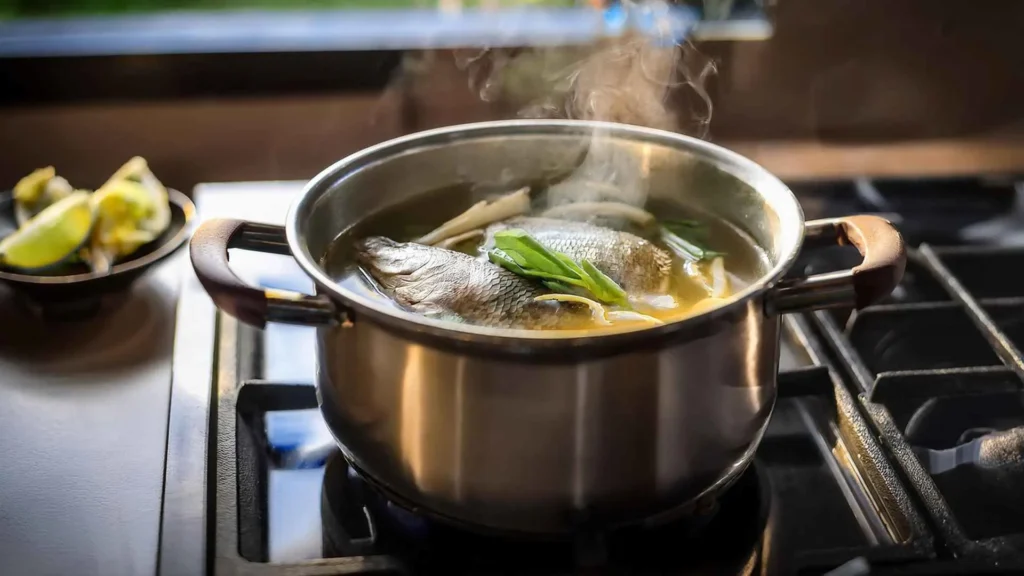Introduction to Fish Head Soup
Fish head soup is a dish that seamlessly blends rich flavors, nutritional benefits, and cultural significance. With roots in diverse culinary traditions worldwide, this soup has grown in popularity for its depth of flavor and health-enhancing properties. In this article, we dive into the many benefits of fish head soup, uncovering its nutritional profile, health advantages, sustainability, preparation tips, and regional variations. Join us on this flavorful journey to discover why adding fish head soup to your diet can be both delicious and rewarding.
Table of Contents
1. Miraculous Health Benefits of Fish Head Soup
1.1 Origin and History
The tradition of fish head soup stretches back centuries, with origins rooted in the practice of utilizing the entire fish for nourishment and taste. This age-old dish reflects the ingenuity of cultures that recognized the value of each part of their ingredients.
1.2 Culinary Tradition
Across various cuisines, fish head is celebrated for its distinct taste and nutritional richness. Whether in the form of a Chinese fish head broth or a Scandinavian fish head stew, this ingredient holds a cherished place in many kitchens around the globe.
2. Nutritional Value of Fish Head in Soup
2.1 Omega-3 Fatty Acids
Fish head soup is packed with omega-3 fatty acids, which are essential for brain function, cardiovascular health, and overall well-being. Incorporating this nutrient-dense dish into your diet is an enjoyable way to boost your omega-3 intake.
2.2 Protein Content
A generous source of protein, fish head soup offers a fulfilling addition to any meal. Protein is vital for muscle repair and growth, ensuring your body stays energized and healthy.
3. Flavor Profile and Culinary Uses
3.1 Richness and Depth of Flavor
Fish heads contribute an opulent richness and umami flavor to soups, turning simple recipes into culinary masterpieces. The unique textures and flavors provide an elevated dining experience cherished by food lovers.
3.2 Versatility in Cooking
Fish head soup lends itself to various preparations, from warming broths to hearty stews. Its adaptability invites creativity in the kitchen, allowing chefs and home cooks alike to experiment and personalize their meals.
4. Health Benefits of Consuming Fish Head Soup
4.1 Promotes Brain Health
The omega-3 fatty acids present in fish head soup are known for their brain-boosting qualities, aiding cognitive functions and mental clarity. Regular consumption of this dish can support overall brain health.
4.2 Supports Heart Health
Fish head soup is an excellent heart-healthy choice due to its omega-3 content. These essential fats help reduce inflammation, lower cholesterol, and enhance cardiovascular function, making the soup a great addition to a balanced diet.
5. Sustainability and Cost-Effectiveness
5.1 Utilization of Whole Fish
Preparing fish head soup maximizes the use of the entire fish, minimizing food waste. This resourceful approach is akin to using every last bit of an ingredient, ensuring nothing goes to waste.
5.2 Economic and Environmental Impact
Incorporating fish heads into meals not only saves money but also contributes to a more sustainable food system. By using fish parts that might otherwise be discarded, you make an eco-friendly choice that benefits both your wallet and the planet.
6. Preparation and Cooking Tips
6.1 Cleaning and Preparing Fish Heads
The idea of preparing fish heads may seem daunting, but it can be simple with the right steps. Rinse thoroughly, remove any gills or scales, and you’re ready to create a delectable fish head soup.
6.2 Cooking Techniques for Optimal Results
When cooking fish head soup, consider gentle techniques like simmering or steaming to extract maximum flavor without overcooking. Think of it as a dance—balancing time and temperature to highlight the fish’s natural taste.
7. Cultural Significance and Regional Variations
7.1 Traditional Fish Head Soup Recipes
Fish head soup embodies cultural richness, celebrated across continents from Asia to Europe. In countries such as Malaysia and China, this dish is cherished for its bold flavors, while European recipes showcase different, hearty interpretations.
7.2 Regional Variations and Specialties
Fish head soup adapts to local tastes wherever it’s made. In Malaysia, expect a spicy curry infusion, while Scandinavian versions might feature root vegetables. All these variations are a different perspective on this staple dish.

Ingredient Table :
| Ingredient | Quantity |
|---|---|
| Fish head | 1 (cleaned and prepared) |
| Water or fish stock | 4-6 cups |
| Ginger | 1 piece (sliced) |
| Garlic | 2-3 cloves (crushed) |
| Onion | 1 (sliced) |
| Tomatoes | 2 (chopped) |
| Green chili (optional) | 1-2 |
| Lemongrass (optional) | 1 stalk |
| Salt | To taste |
| Pepper | To taste |
| Lemon or lime juice | 1 tbsp |
| Fresh cilantro | For garnish |
| Vegetables (optional) | As desired |
8. Cooking Fish Head Soup: Step-by-Step Guide
Fish head soup is a dish that is both simple to prepare and rich in flavor. Below is a straightforward step-by-step guide to creating a delicious fish head soup that captures the essence of this traditional dish.
8.1 Step-by-Step Cooking Instructions
Prepare the Fish Head:

Begin by ensuring your fish head is clean. Remove any gills and scales, and give it a thorough rinse under cold water. This step is crucial to remove any impurities and ensure a fresh base for the soup.
Sauté Aromatics:
In a large pot turn the heat to medium and then add a drizzle of oil. Add the sliced ginger, crushed garlic, and onions, and sauté until fragrant. This forms the aromatic base of your soup, providing depth and warmth.
Add Tomatoes and Spices:
Incorporate the chopped tomatoes and optional green chili into the pot. Sauté for a few minutes until the tomatoes start to break down and release their juices.After that add the salt and the pepper to your own desired preference.
Simmer the Soup:

Pour in the water or fish stock and bring the mixture to a gentle boil. Add the prepared fish head and lemongrass (if using), and lower the heat to a simmer. Allow the soup to cook for 20–30 minutes, ensuring the fish head is fully cooked and the flavors meld beautifully.
Finishing Touches:
Before serving, squeeze in the lemon or lime juice for a burst of brightness. Taste and adjust the seasoning as needed.
Garnish and Serve:
Ladle the soup into bowls and garnish with fresh cilantro for a touch of color and added freshness. You can also add any desired vegetables at this stage for additional texture and nutrition.
8.2 Tips for Enhancing Flavor
- For an even deeper flavor, consider roasting the fish head briefly before adding it to the soup.
- Use homemade fish stock for a more robust and nuanced base.
- Experiment with herbs like dill or parsley to introduce new layers of flavor.
9. Serving Suggestions and Pairings
Fish head soup is hearty and flavorful on its own, but pairing it with complementary sides can elevate the dining experience. Consider serving it with:
- Steamed Jasmine Rice: The light, fluffy texture of jasmine rice pairs perfectly with the rich, savory notes of the soup.
- Crusty Bread: A slice of crusty bread can be used to soak up the flavorful broth for an added indulgence.
- Fresh Salad: A simple salad with a light vinaigrette provides a refreshing contrast to the warm and rich soup.
- Pickled Vegetables: The tangy and crisp bite of pickled vegetables adds a burst of acidity that balances the soup’s flavors.
Tips for Enjoying Fish Head Soup at Its Best
1. Select the Freshest Fish:
Always opt for fresh fish heads, as their quality directly influences the taste of your soup. When purchasing, look for bright, clear eyes and a clean, briny smell.
2. Experiment with Flavors:
Don’t be afraid to experiment with additional seasonings or regional ingredients. Adding coconut milk for a Southeast Asian twist or saffron for a Mediterranean touch can elevate the dish further.
3. Serve Immediately:
Fish head soup is best enjoyed fresh. Serve it as soon as it’s cooked to preserve its flavors and ensure optimal texture.
4. Share the Experience:
Fish head soup is a dish meant for sharing. Invite friends or family to savor its rich flavors together, creating not just a meal but a warm, communal experience.
Exploring the tradition of fish head soup means embracing a dish that is both humble and sophisticated, merging simplicity with deeply satisfying flavors. By savoring the unique blend of tastes and honoring the cultural roots that make this dish so special, you not only nourish your body but also pay homage to generations of culinary wisdom.
Let your cooking adventure with fish head soup be an exploration of taste, sustainability, and culture. Enjoy the process, take pride in mastering new recipes, and relish the satisfaction of creating a dish that’s steeped in tradition and brimming with health benefits. Happy cooking!
Conclusion: Embracing the Tradition
Fish head soup is more than just a dish; it’s a testament to the creativity and ingenuity of global culinary traditions. By making use of every part of the fish, this soup not only reduces waste but also offers exceptional nutritional benefits and culinary satisfaction. Whether you’re a seasoned chef or an adventurous home cook, exploring fish head soup can open up a world of flavors, cultural appreciation, and sustainable cooking practices.
So, embrace this hearty, nutritious dish and savor the rich history it carries with every spoonful. Dive into the process, try new variations, and share the joy of fish head soup with friends and family. Let your kitchen be a space where tradition and taste converge, creating memorable meals that celebrate the simple beauty of good food.
FAQ Continued
Is it safe to eat fish head soup?
Yes, fish head soup is safe to consume when properly prepared and cooked. It’s important to ensure that the fish head is fresh and cleaned thoroughly before cooking. Removing gills and scales and washing the head well can help eliminate any potential contaminants. Cooking at a suitable temperature will also ensure that any harmful bacteria are neutralized, making the dish safe and nutritious.
What are some common types of fish used for making fish head soup?
Fish head soup can be made using a variety of fish species. Popular choices include:
- Salmon: popularly known for its great taste and high content of omega three fatty acids.
- Snapper: A mild-tasting fish that adds depth without overpowering other ingredients.
- Cod: Provides a light, flaky texture and delicate taste.
- Carp: Often used in Asian dishes for its strong flavor.
- Grouper: Common in Southeast Asian recipes for its firm flesh and distinct taste.
Each type of fish offers its own unique flavor profile and nutritional benefits, allowing for versatility in preparation.
Are there any vegetarian alternatives to fish head soup for similar nutritional benefits?
For those following a vegetarian or plant-based diet, there are creative ways to mimic the nutritional benefits and flavors of fish head soup:
- Seaweed Broth: Rich in umami flavor and packed with minerals like iodine and magnesium. Adding miso paste can boost the protein content and deepen the flavor.
- Mushroom Stock: Using shiitake mushrooms or other varieties can create a rich, earthy broth with a similar depth to fish-based soups.
- Plant-Based Omega-3 Sources: Include flaxseeds, chia seeds, and walnuts to your diet to gain similar health benefits provided by fish.
- Kelp and Kombu: These sea vegetables infuse broths with a sea-like taste, perfect for those seeking the essence of seafood in a vegetarian context.
How can I enhance the flavor of fish head soup?
To enhance the flavor of fish head soup, consider the following tips:
- Spices and Aromatics: Adding ginger, garlic, onions, and lemongrass can impart a fragrant and savory depth to the soup. These ingredients balance the natural fish flavor and elevate the dish.
- Herbs: Fresh herbs like cilantro, dill, or basil can add a bright note to the soup, especially when garnished just before serving.
- Acidity: A splash of lemon juice or tamarind can introduce a tangy contrast, cutting through the richness of the fish head.
- Broth Base: A well-made broth, whether vegetable or fish-based, serves as the foundation. Ensure it’s seasoned well with salt and pepper for added depth.
- Chili Peppers: For a spicy kick, consider adding fresh or dried chili peppers to your fish head soup.
How long should fish head soup be cooked?
The cooking time for fish head soup varies based on the size of the fish head and the recipe being followed. However, generally:
- Simmering Time: Fish head soup typically takes about 30 minutes to 1 hour of simmering to allow the flavors to meld and the fish to cook thoroughly. Ensure that the fish head is tender but not overcooked to avoid a mushy texture.
- Do not overcook: Overcooking the fish can result in the flesh breaking down and the soup becoming cloudy. Keep the cooking time to a minimum to maintain the soup’s clarity and texture.
Can I make fish head soup ahead of time?
Yes, fish head soup can be made ahead of time and stored in the refrigerator for up to 2-3 days. In fact, some people believe that the flavor improves as it sits, allowing the ingredients to meld further.
- Storage: After preparing the soup, let the meal cool down totally then put it in an airtight container. When reheating, ensure it is heated thoroughly but avoid boiling it again, as this can alter the texture of the fish.
- Freezing: While you can freeze fish head soup, the texture of the fish may change after thawing. For best results, freeze only the broth and add fresh fish heads when reheating.
How do I serve fish head soup?
Fish head soup is often served as a main dish or as part of a multi-course meal. Here are some ideas for serving:
- Garnishes: Top the soup with freshly chopped herbs like cilantro or parsley, and serve with a wedge of lime or lemon on the side.
- Side Dishes: Pair the soup with steamed rice, noodles, or crusty bread to soak up the rich broth.
- Accompaniments: For added texture and flavor, you can serve the soup with a side of pickled vegetables or a simple salad.
What are the health benefits of fish head soup?
Fish head soup is packed with nutrients that are beneficial for overall health:
- Rich in Omega-3 Fatty Acids: Fish head soup is a great source of omega-3 fatty acids, which are essential for heart health, brain function, and reducing inflammation.
- High in Protein: The fish head provides a good amount of protein, which is essential for muscle growth, tissue repair, and immune function.
- Bone Health: Fish heads, especially when simmered for a long time, release collagen and calcium, which contribute to strong bones and joints.
- Vitamins and Minerals: Fish head soup contains important vitamins like vitamin A, vitamin D, and B-vitamins, as well as minerals like iodine, selenium, and zinc.
Put I make fish head soup from frozen fish head?
Yes, you can use frozen fish heads to make fish head soup, although it’s best to thaw them before cooking. Freezing fish heads preserves their nutrients and can be a convenient option when fresh fish heads are not available. However, be sure to properly thaw the fish heads in the refrigerator overnight or under cold running water before using them in your soup.
Final Thoughts
Exploring the world of fish head soup offers a unique opportunity to savor both tradition and nutrition. Whether it’s the protein boost, omega-3 benefits, or the deep, luxurious flavor that entices you, this dish has something special to offer. By embracing this time-honored recipe, not only are you expanding your culinary horizons, but you’re also contributing to sustainable eating practices that honor the whole fish.
So, whether you’re crafting a classic fish head broth, spicing things up with a Malaysian curry, or exploring vegetarian substitutes that capture the soup’s essence, let each bowl be a celebration of taste, history, and health. Dive into the world of fish head soup and discover why this dish has stood the test of time across cultures and generations.
soup fish head






